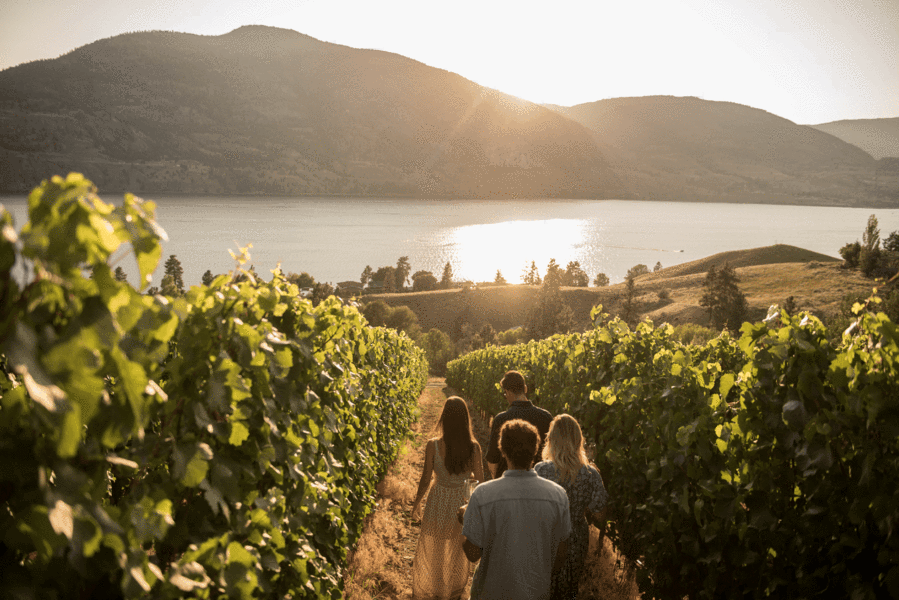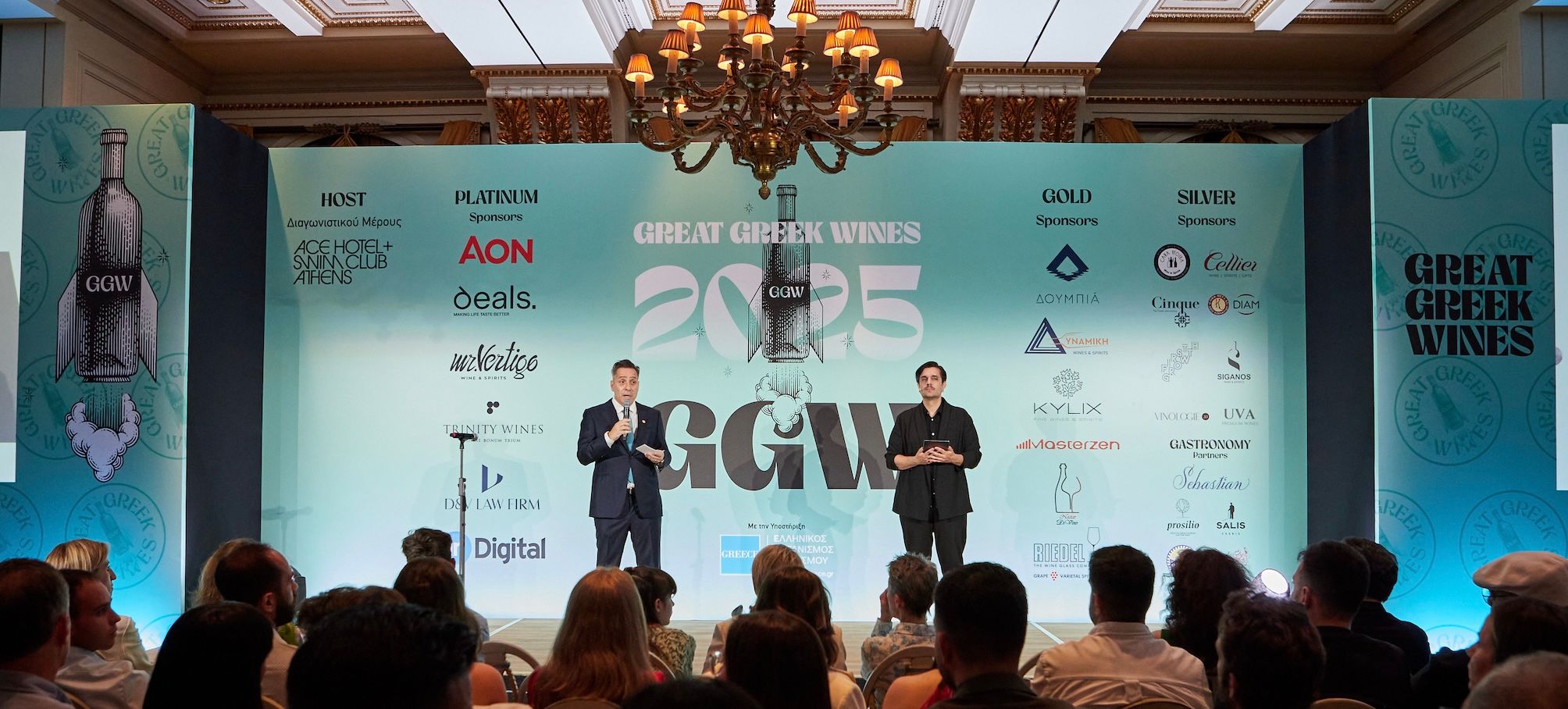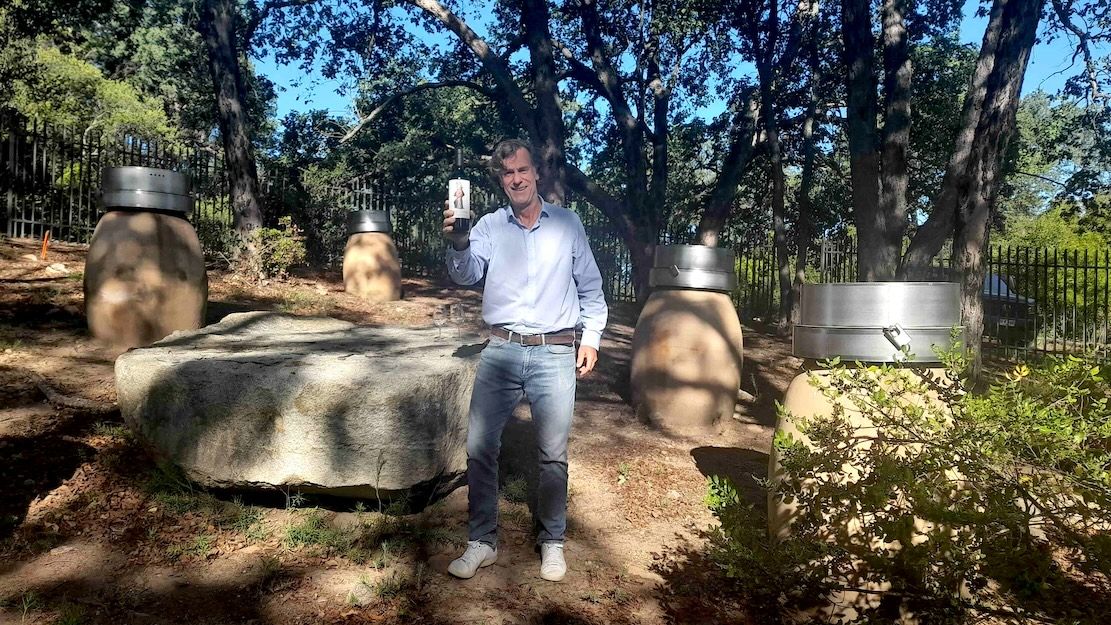Having never been to Canada I did not know quite what to expect on embarking on my first foray to the actual part of North America that can genuinely live up to the claim. I expected it to be big and that did not disappoint. I expected it be beautiful and it was simply stunning. I expected the people to be nice, but not quite so friendly and welcoming as they were
And I expected lots of healthy fresh food, and produce and was blown away by the chance to taste so many different cuisines. Mind you what I did not expect was to be involved in actually helping to cook some of it myself. Well, by cook I mean being asked by a persuasive chef, Ned Bell, to pull the heads and tails of squirming spot prawns the size of my hand so that we could eat (he was doing a cooking demonstration rather than just plucking me out of the restaurant).

Wine trip experiences? Shelling live prawns…ouch!
What I had no idea about what to expect was how good its wines would be having only really come in contact with ice wine in the past. Which whilst nice enough is hardly enough to get you on a plane and travel 10 plus hours to explore.
Looking back on my trip to Canada and my experiences and memories are all now largely seen through the bottom of a wine glass. All washed down with tales, wisdom and bonhomie of all the winemaking families we met up and down the Okanagan Valley, the cream of the British Columbia wine trade (and 80% of it), just north (well in Canadian terms) of Vancouver.
Or to be exact the seven wineries that make up the Okanagan Wine Initiative of like minded producers that came together earlier this year to allow their collective talents to shine together as one, and help raise the profile of not only their own wines, but that of the Okanagan region and Canada as a whole. Which considering Canada’s wine exports only make up 0.02% of all global wine export volumes and 0.1% by value it has some way to go, particularly as its represents only 0.3% of the world’s total wine production.
Its mandate is to collaborate so that the producers can collectively improve all areas of their viticulture, winemaking and winery operations. They also hope to create a benchmark of quality for the region that other producers can potentially follow. The producers in the OWI are 50th Parallel Estate Winery, Culmina Family Vineyards, Haywire Wines, Liquidity Wines, Painted Rock Estate Winery, Poplar Grove Winery, and Summerhill Pyramid Winery.
Outside to the inside
Other than the fact they all make wine and have a great big lake as their view, there is actually quite a lot that brings the Okanagan Seven together. The majority may now see the wine industry as their future, it’s not been the journey that has gone them to where they are now. In fact they’re quite an eclectic bunch of talents. Ideal as Dragons as on the Dragons Den, withmore than their fair share of disposable income.
With land as expensive as in the Napa Valley you can’t just do an oenology degree and expect to make wine in the Okanagan. Some of the prime sites go for $120,000 plus a hectare and are getting more expensive and they get snapped up with days if not hours of going on the market.
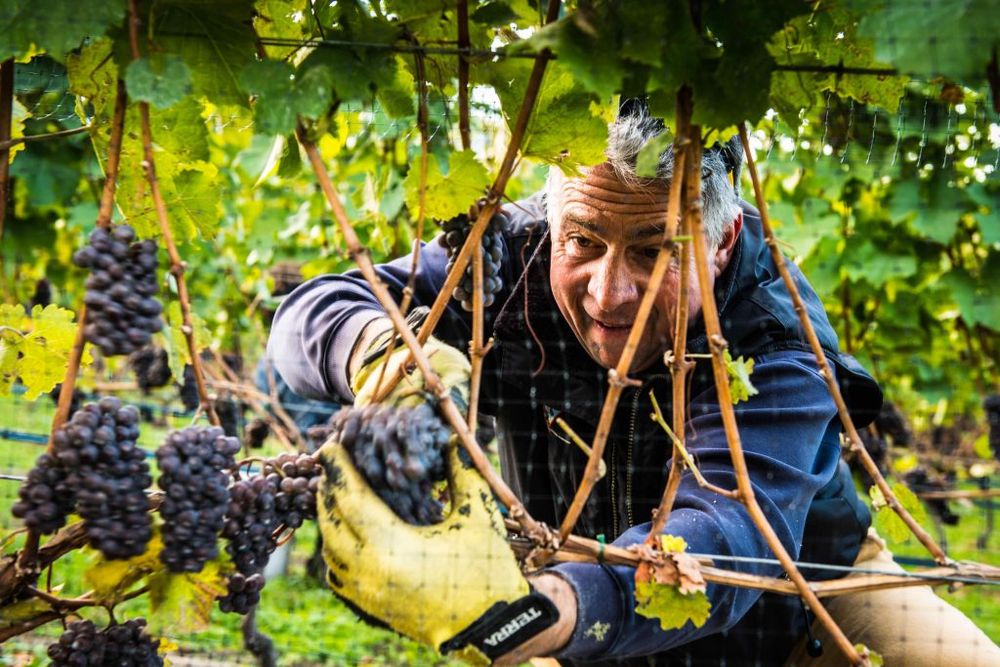
Poplar’s Tony Holler getting stuck into his grapes
“If a site comes up you have to jump on it and then work out what to do with it,” says Tony Holler, who has given up medical laboratories and his vaccines business to turn to wine and the Poplar Grove winery.
John Skinner at Painted Rock is a former investment banker, with friends in all the right places to help with investment in his own winery. Curtis and Sheri-Lee Krouzel, owners of 50th Parallel Estate, might look they have come straight out of a rock band, but they were actually a highly successful gas and oil engineer and health and fitness expert respectively before moving into wine.

Curtis and Sheri-Lee Krouzels are focused on producing the best quality Pinot Noir
Then there is Steve Lornie behind the Okanagan Crush Pad who had a career in property and construction – hence the cool looking winery – alongside his wife, Christine Coletta, who is one of the few in the group to have a long track record in wine having started the British Columbia Wine Institute and Wines of Canada.
She says the fact they can all bring different skills to the table makes them even more effective as a group. “We don’t claim to be the best, but we know by working together we can all call bullshit on each other and challenge, help and support us all to do better,” she explains.
Winemaking philosophies
All those very different experiences means they naturally have a varied approach when it comes to winemaking, which is not just based on their location.
The Okanagan Grape Crush is all about cement with more egg fermenters on show than you would get at Cadbury’s leading up to Easter.

Attack of the Minions: concrete eggs at Okanagan Crush Pad
Culmina Family Vineyards is prepared to give everything a go and has oak barrels, stainless steel tanks, concrete eggs and a concrete amphora to try and do different things to the wine. Each of the components are then blended together, or not as the case might be, for each of the wines.
“It’s like doing a barrel programme, but at the fermentation stage,” says Sarah Triggs, daughter of the Triggs family that own the Culmina property.

Summerhill’s pyramid: the most spiritual ageing cellar in the world?
The Summerhill Pyramid Winery is something else altogether. Here, where the primary focus is on producing sparkling wine, literally anything goes. In fact the first thing you notice on arriving, other than the coach loads of Chinese tourists, is the large pyramid it has sitting over its priority.
Now quite what the role of the pyramid is probably needs a separate article, but it is a four storey, 3,249 square foot replica of the Great Pyramid in Egypt. But essentially, founder Stephen Cipes, sees it having a spiritual influence over the vines, the winery and also the bottles of wine (grown organically) that are aged for some of their time within the pyramid’s sacred centre.
He explains: “The word Py-ra-mid means ‘fire in the middle’. We all have this fire in the middle. It is our hearts, our souls. We are mostly liquid and we are affected just like the wine is effected. The effect is clarification. If a wine has a flaw in it, the flaw is accentuated. If the wine has good qualities, they are enhanced.”
Whatever the approach it works. “We have a 20 year experiment proving the effect of sacred geometry on liquids with a 20 year track record of international gold medals,” he adds.
The theory goes that the fruit in the sparkling wines come out more after being in the pyramid, and the wines taste fresher. Hence the idea that it enhances whatever you put into pyramid.
However they get there, they all clearly share a commitment to make modern style wines, that are true to the vineyards they have. Wines that also happen to be ideal for building their profiles and exports overseas.
Wines that are, on the whole, as calm as the 70 plus mile glacial lake that stretches up the 140km Okanagan valley, which has so much to do with how they are made.
Unique glacial climate

The glacial lake has such a significant influence on the wines of the Okanagan Valley
The Okanagan valley is blessed with a climate, that can mean 18 hours of sunlight a day at some times of the year, that just demands its winemakers make refined, elegant wines. It also enjoys huge discrepancies in temperature between day and night – which can go from 20°C in winter and over 40°C in summer in parts.
But it is the calming, cooling influence of the 70 plus-mile long lake that truly dominates proceedings keeps things nice and balanced through the winter and summer. Being 800 feet deep in places it has its own equivalent of the Loch Ness Monster – the Opopogo -to allure tourists and amuse locals.
Here you can find acidity and as many stones, minerals and fruity flavours in your wine as you like. What you won’t get is big, chalky tannins, and alcoholic blockbusters dripping in rich, confected fruit. Alcohol levels on some of the reds might sit at 14% to 15%, but they are on the balanced side of the fence.
In the main they produce wines that share a linear precision, particularly on the white, that evoke the astonishing attention to detail that has gone into making them.
The climate, soils and influence of the glacial valley means there is great diversity and micro climates in the vineyards with some 60 different varietals planted.
But if it was entering varieties into a global competition then it would be its Sauvignon Blancs, Chardonnays, Pinot Gris, Pinot Noirs from the whites and Gamays, Cabernet Francs and Syrahs that it would be putting its money behind.Even if it prefers not to be pigeon holed in such a way.
We had the chance to taste a whole range of styles of wine, with some quality Chenin Blancs, Grüner Veltliners and Gewürztraminers, Viogniers across the seven producers.
Willing to experiment
Probably because the producers are all still feeling their way. After all the majority have only been making wine for 20 years or less and are still very much at the experimental, “what happens if we plant this there” stage.
The producers we met had each sent a huge amount of time and money carrying out GPS soil and satellite analysis of their lands in order to best choose the right vines, and right varieties to plant.
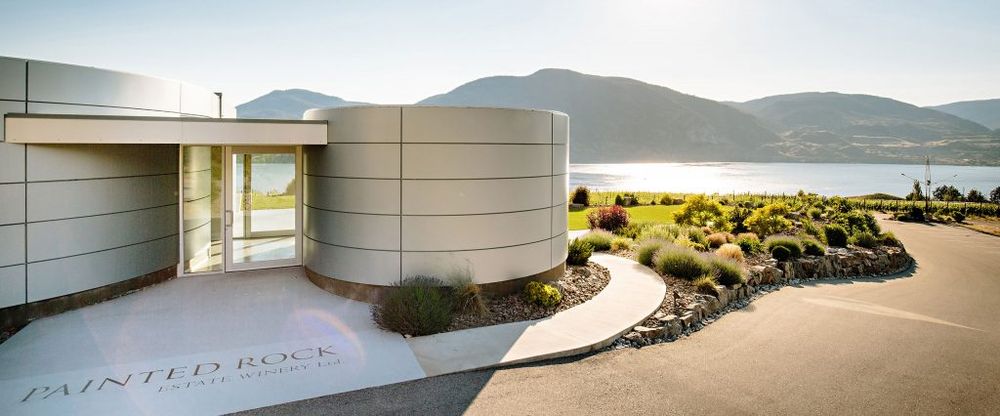
Party winery, part cellar, part James Bond hang out. Painted Rock right on the shore of Okanagan’s lake
John Skinner says it took him five years before deciding what vines to plant at Painted Rock (imported by The Wine Treasury) and even after all the analysis he brought in top Bordeaux consultant, Alain Sutre, to make sure he was doing everything right.
“There is so much planning and analysis that goes into everything that we do. Because we are in the shadow of a mountain it means some vines can get 45 minutes an hour sunshine. So it needs incredible time and investment to get things right,” says Skinner.
“For example, it has made a big difference planting our vines east to west down towards the lake.”

The winery, cellars and restaurants of the 50th Parallel winery are truly breathtaking
The Krouzels at 50th Parallel Estate are throwing everything at the idea of making world class Pinot Noir. Every attention to detail has been thought of at a winery that is in the running for major architecture awards as it is for its winemaking. They have also put the miles in. Travelling and visiting Pinot Noir producers the world over to see what they can bring back and do the same but different in Okanagan.
Tony Holler says he purposely bought land in the south of the valley for Poplar Grove as it was the best place for him to grow his much loved Bordeaux varietals like Cabernet Sauvignon and Cabernet Franc. But he also knows he has a long way to go with vines only 10 years old.
“Everything is site specific for what grapes can grow where. It’s like the tapestry in Burgundy,” he adds.
Liquidity Wines is very much a new kid on the block in terms of producing wine under its own name, with its first release only in 2010, but has been growing and selling grapes for over 20 years and has vines that are 30 years and more old on its 30 acre estate.
Here the focus is very much on Pinot Noir and Chardonnay, with 1,200 and 700 cases produced on average a year. Here the Pinot Noir is the star attraction with what winemaker, Alison Moyes, says is more of a New Zealand, Central Otago style. It is also having some success with its Pinot Gris, Riesling, Viognier plantings and inherited some Dornfelder vines.
Differences north to south
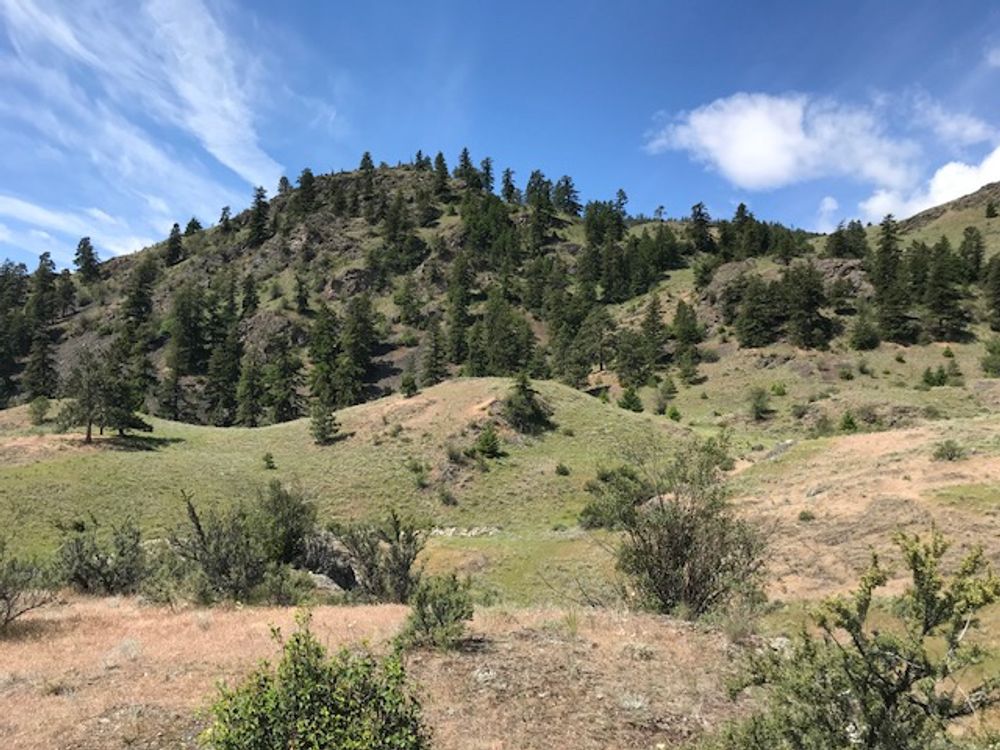
Culmina is one of the highest properties in the valley
There is also an enormous difference in rainfall between the top of the valley, which gets around 400mm a year and the south up to the US border, which largely operates in near desert like conditions with only 250mm of rain if you are lucky. But it’s hardly teaming with rain and the wineries have to use a variety of different irrigation methods to keep their vines hydrated. Again they have a lot to be thankful of the lake for.
The Poplar Grove Winery is the star attraction down in the south and its here where the wines get as concentrated as they can in the valley. Here temperatures are often 40ºC in the summer, but then are only 12–13º at night, providing the perfect high low balance for the grapes.
There are also big differences in the altitude where vines are grown in the valley. Culmina Family Estates, for example, is one of the highest at 600m.
But then differences are what the Okanagan Valley is all about.
- In the second part of our analysis of the Okanagan Valley we look at the wines themselves, which brands are making a name for themselves and how the producers are bringing in outside expertise to help them fast track their development.
